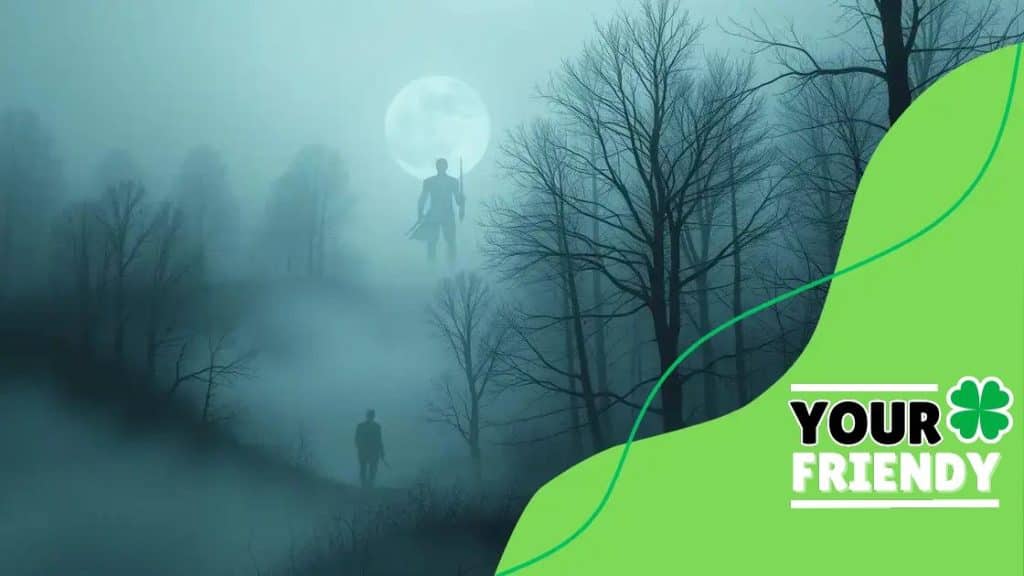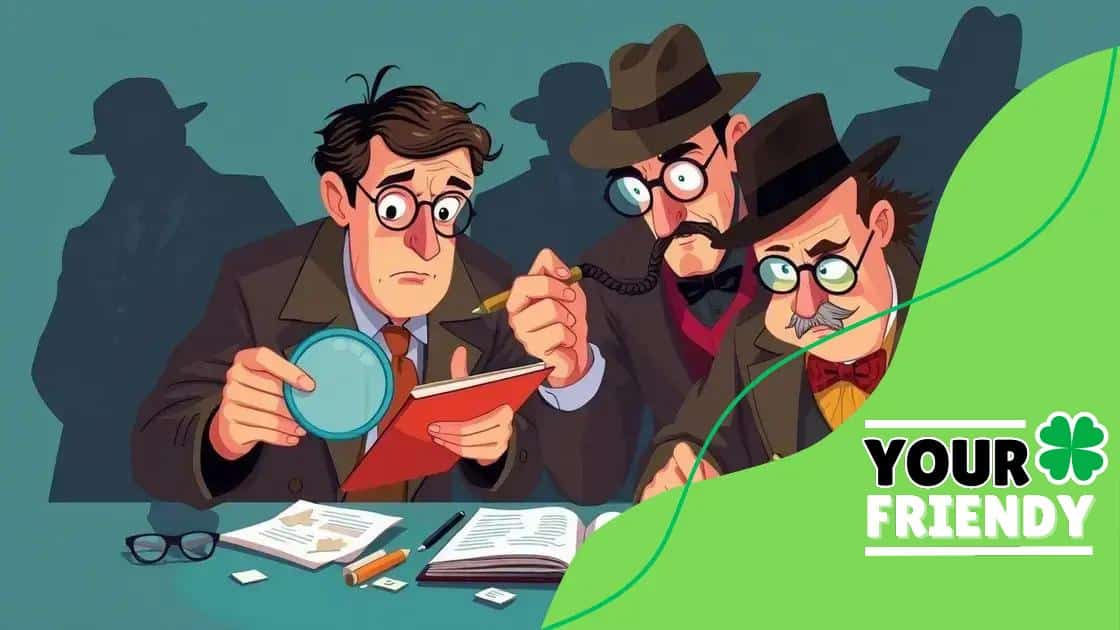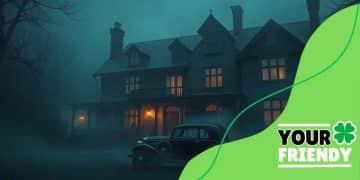Unsolved mysteries challenging characters to ponder

Anúncios
Unsolved mysteries challenge our understanding of human nature by revealing complex motivations, igniting curiosity, and inspiring stories that explore morality while fostering community dialogue around shared experiences.
Unsolved mysteries challenging characters often spark our curiosity, leading us to question everything we know. Have you ever found yourself captivated by a story that leaves you guessing? Let’s dive into some of the most intriguing enigmas.
Anúncios
Exploring the most perplexing unsolved mysteries
There are many unsolved mysteries that continue to baffle experts and enthusiasts alike. From ancient artifacts to modern-day disappearances, each mystery tells a unique story that captures our imagination. Let’s take a closer look at some of the most perplexing ones.
The Wow! Signal
In 1977, astronomer Jerry R. Ehman detected a strong radio signal from space, which he labeled the “Wow! signal.” This brief burst of radio waves from the direction of the Sagittarius constellation has never been explained. Could it have been a sign of extraterrestrial intelligence? The mystery remains unsolved, leaving scientists and enthusiasts speculating.
The Disappearance of the Sodder Children
On Christmas Eve in 1945, a fire destroyed the Sodder family home in West Virginia. Five of the ten Sodder children were never found. Even after sightings and potential leads, their fate remains a mystery. Here are some key points:
Anúncios
- The family received strange phone calls before the fire.
- Some witnesses claimed to have seen the children after the incident.
- The family believed they were kidnapped rather than perished in the fire.
This case still poses questions that perplex investigators and true crime aficionados alike.
Another unsolved mystery revolves around the identity of the Zodiac Killer. This infamous serial killer operated in California during the late 1960s and early 1970s. Though he claimed to have killed 37 people, only five murders are confirmed. Despite numerous investigations and various suspects, the identity of the Zodiac Killer remains shrouded in secrecy. The killer sent encrypted messages to the press, some of which are still unsolved.
The Loch Ness Monster
Legends of the Loch Ness Monster have captivated audiences for generations. Reports of a large creature lurking in Scotland’s Loch Ness date back to the 6th century. Despite many photographs and claims of sightings, no physical evidence has been found to confirm its existence. Is it a folklore tale or a mysterious creature waiting to be discovered? The debate continues to intrigue.
In conclusion, these unsolved mysteries highlight humanity’s desire to understand the unknown. They remind us that some questions may never be fully answered, yet they continue to inspire curiosity and exploration.
The impact of these mysteries on literature and media
The impact of these mysteries on literature and media is profound. Throughout history, unsolved mysteries have inspired countless books, movies, and television shows. They captivate the imagination and invite audiences to explore the unknown, creating a sense of intrigue that is hard to resist.
Mysteries in Literature
Many authors have used unsolved mysteries as a backdrop for their narratives. Books like “And Then There Were None” by Agatha Christie delve into the suspense and tension built around enigmatic events. These stories often leave readers guessing until the end, which keeps them engaged. Authors use the element of mystery to connect with their audience by making them part of the investigation.
The Influence on Films
In film, the allure of unsolved mysteries has led to many successful movies. Consider films like “Zodiac” and “The Others.” Both explore real-life enigmas and create immersive experiences for the viewer. This fascination draws people in, invites them to solve puzzles alongside the characters, and often leads to discussions and theories long after the credits roll.
The media coverage of unsolved cases often shapes public perception and interest. For instance, the mysterious case of the Zodiac Killer has produced documentaries, podcasts, and countless articles. Each new piece of media adds layers to the existing mystery, fueling both intrigue and speculation.
Television Shows and Series
Television has also leveraged the curiosity around unsolved mysteries. Shows like “Unsolved Mysteries” and “The X-Files” combine storytelling with investigative elements, often blending fact and fiction. This format keeps viewers engaged while tackling real questions about unresolved issues.
The impact is not limited to genre fiction; documentaries on true crime and unsolved cases draw large audiences, illustrating a cultural obsession with the unknown. People crave answers, and these mysteries provide a never-ending source of fascination.
Famous fictional characters shaped by mysteries

Many famous fictional characters have been shaped by the mysteries they encounter. These characters often find themselves deep in puzzling situations, and their responses to these challenges can reveal much about their personalities. One prime example is Sherlock Holmes, the iconic detective created by Sir Arthur Conan Doyle. His unmatched analytical skills and keen observation make him a master at solving even the most complex cases.
Sherlock Holmes
Holmes not only embodies the essence of a detective, but also makes the reader think critically. His adventures spark curiosity and encourage readers to follow the clues while attempting to solve mysteries alongside him. This lasting impact on detective fiction has inspired countless adaptations and imitators.
Hercule Poirot
Another celebrated character is Hercule Poirot, also from Agatha Christie’s works. Poirot is a Belgian detective known for his meticulous methods and reliance on psychology to solve cases. His unique perspective on human behavior often leads to surprising conclusions. With each mystery, viewers get a glimpse into Poirot’s thought process, making them marvel at how he unravels the truth.
Characters like these not only entertain but also teach essential lessons about observation and deduction. They often symbolize the quest for truth, a theme that resonates with readers across generations. Further, they create a unique blend of suspense and excitement, ultimately forming strong emotional ties with the audience.
Miss Marple
Aunt Jane Marple is yet another remarkable character arising from the mysteries of small-town life. Her unassuming appearance hides a sharp mind. Miss Marple notices what others overlook, which helps her piece together the puzzles of crime. Readers appreciate her quiet wisdom and the gradual manner in which she reveals the truth.
The influence of these characters extends beyond their specific narratives. They have sparked numerous adaptations in films, television shows, and even video games, capturing the imagination of audiences worldwide. The intricate mysteries surrounding them are powered by their unique abilities to interact with the enigmas they encounter, inspiring many to embark on their own quest for answers.
Real-life investigations that inspire stories
Real-life investigations often serve as powerful inspiration for captivating stories. They not only bring excitement but also connect deeply with readers and viewers. One notable case is that of the Black Dahlia, a famous unsolved murder in 1947. The brutal killing of Elizabeth Short sparked numerous theories and inspired countless books, movies, and documentaries.
The Black Dahlia Case
This case remains a source of intrigue. Writers and filmmakers have used the gruesome details to create stories that explore themes of mystery and obsession. The unanswered questions surrounding this case continue to fascinate audiences, making it a popular subject in media.
Jack the Ripper
Another infamous case is that of Jack the Ripper, the unidentified serial killer who terrorized London’s Whitechapel district in 1888. The mystery of his identity and the gruesome nature of his crimes have inspired numerous novels, films, and documentaries. People are drawn to the intrigue surrounding this case, as it raises questions about the human mind and the nature of evil. The list of adaptations inspired by his story is extensive:
- Movies like “From Hell” and “The Ripper” explore his crimes.
- Books such as “The Diary of Jack the Ripper” delve into possible identities.
- Documentaries discuss the social conditions of Victorian London.
These real-life investigations showcase how fact can inspire extraordinary creativity in the arts. They tease human curiosity and lead to exploration of complex themes, such as morality, justice, and the darkness within. Readers and viewers often find themselves pondering these questions long after they engage with the material.
The Zodiac Killer
The Zodiac Killer, operating in California during the late 1960s, is another example of how real crimes shape stories. The killer sent letters to the media, one of which remains unsolved. This sparked numerous books and films that explore his identity and motives. Each adaptation adds layers to the narrative, further igniting public fascination.
Real-life investigations like these provide a rich backdrop for stories, allowing authors and filmmakers to explore the unknown and evoke strong emotions in their audiences. As these stories unfold, they remind us that behind each mystery lies a profound human experience, waiting to be uncovered and retold.
How mysteries challenge our understanding of human nature
Unsolved mysteries challenge our understanding of human nature in many profound ways. They force us to confront the unknown and explore why people behave as they do. When we encounter a mystery, it elicits curiosity and reveals our deepest fears and desires.
The Psychology of Mystery
One way mysteries affect us is by highlighting our psychological responses. For example, consider cases where individuals have gone missing under strange circumstances. These situations can lead to widespread public fascination. People often speculate about motives and reasons, which reflects their need to understand what drives human behavior. Such inquiries can reveal:
- The complexities of human motivation.
- The impact of societal pressures on individual actions.
- How fear and uncertainty influence decision-making.
Moreover, these mysteries can also expose our inherent need for resolution. We are drawn to answers, and the lack thereof can be discomforting. This discomfort can lead to intense analysis and discussion, driving communities to come together in search of the truth.
Mysteries in Literature and Media
The exploration of human nature is prominent in stories involving mysteries. Characters in mystery novels, like detectives or amateur sleuths, embody various aspects of humanity. The decisions they make reveal not only their personalities but also broader themes about morality and ethics. As readers engage with these narratives, they often find themselves questioning what they would do in similar situations. This reflection can be an eye-opening experience, leading to greater self-awareness and understanding.
Additionally, mysteries often expose the darker sides of human nature. They show how fear, greed, and jealousy can lead to desperate actions. This exploration encourages discussions about ethics and morality. By examining the motives behind crimes and mysteries, we gain a better understanding of the human psyche.
Overall, the way mysteries challenge us is a critical aspect of their allure. They serve as a mirror, reflecting our thoughts and feelings about human nature. As we grapple with unanswered questions, we not only seek knowledge but also uncover profound insights about ourselves.
FAQ – Frequently Asked Questions about Unsolved Mysteries and Human Nature
How do mysteries help us understand human nature?
Mysteries reveal the complexities of human motivations and behaviors, prompting us to reflect on our own actions.
Why are people fascinated by unsolved mysteries?
People are drawn to unsolved mysteries because they spark curiosity and invoke a desire to seek answers.
What role do mysteries play in literature and media?
Mysteries inspire countless stories in books and films, engaging audiences and exploring themes of morality and ethics.
How can discussing mysteries build connections among communities?
Sharing thoughts and theories about mysteries fosters dialogue, creating bonds as people seek answers together.





